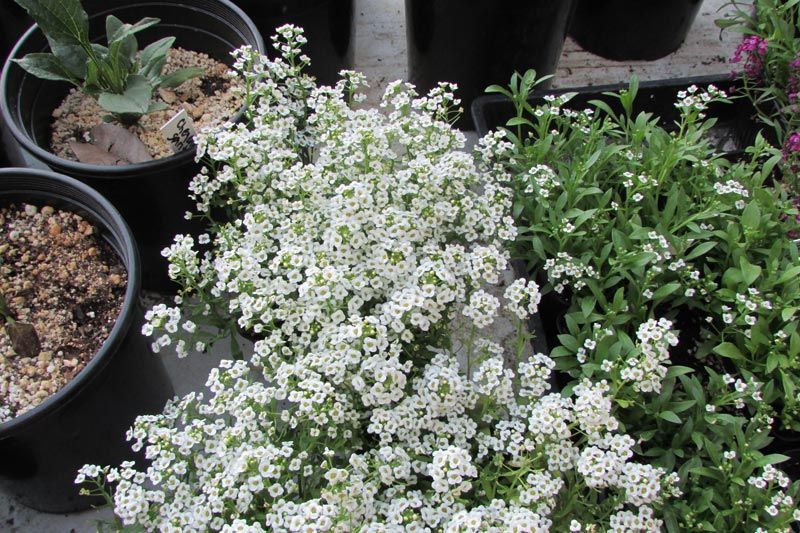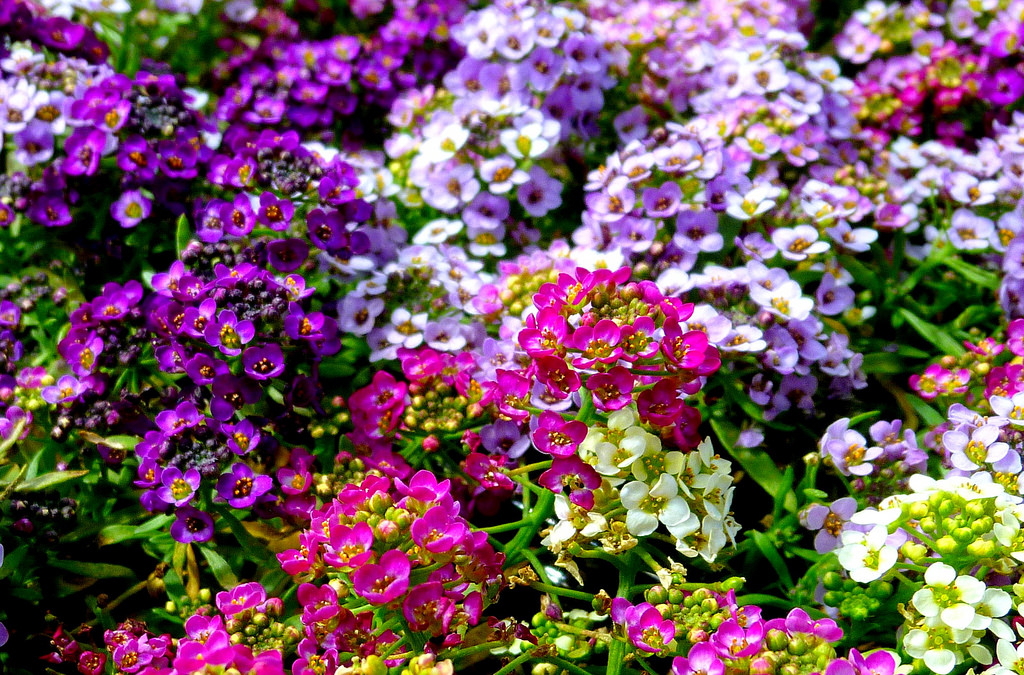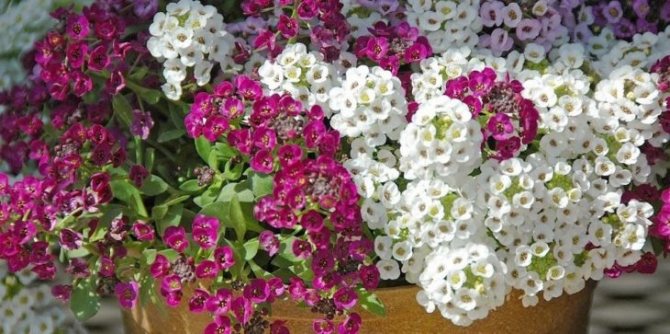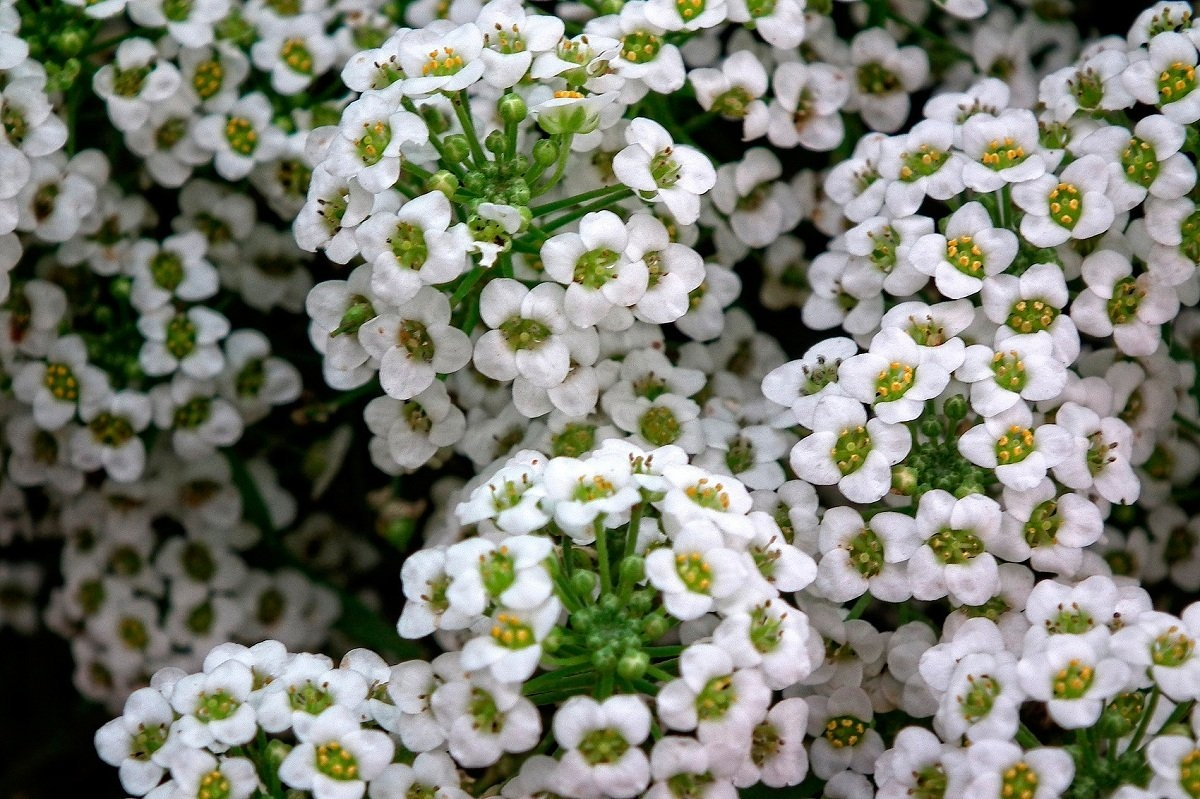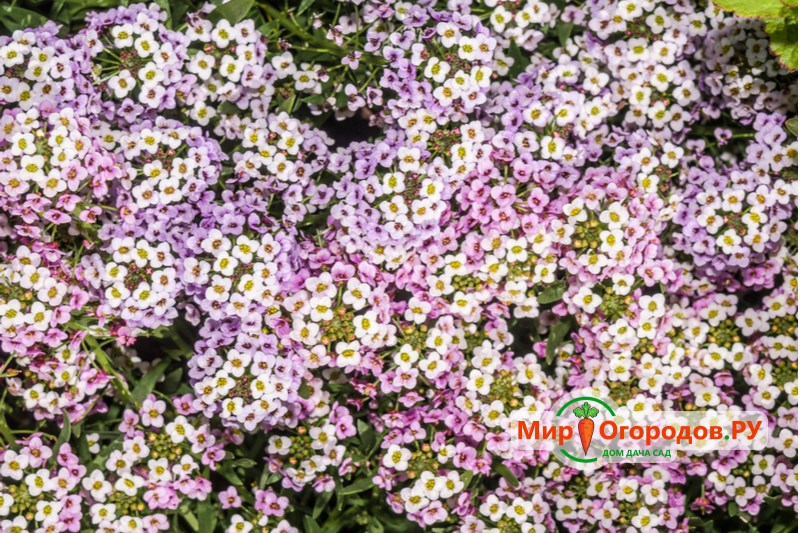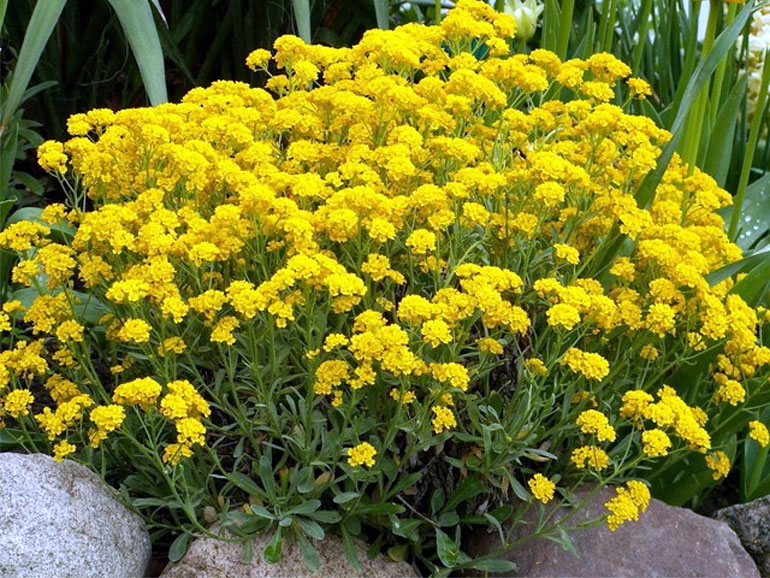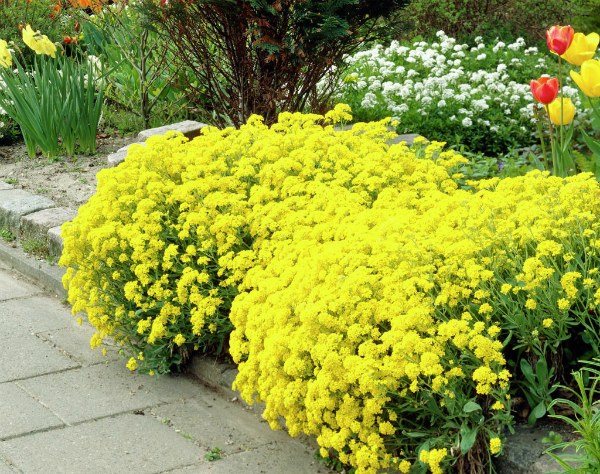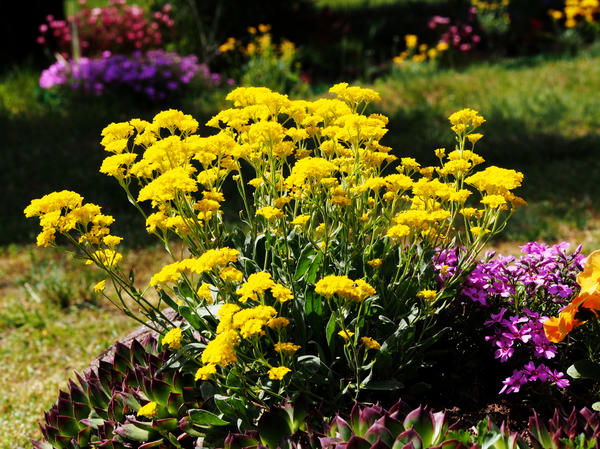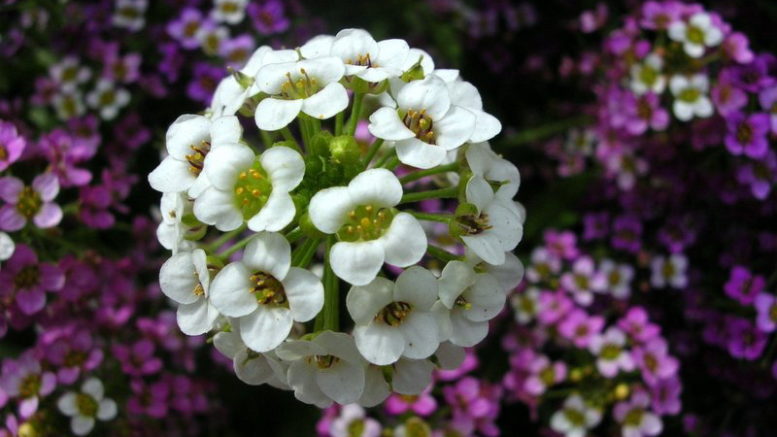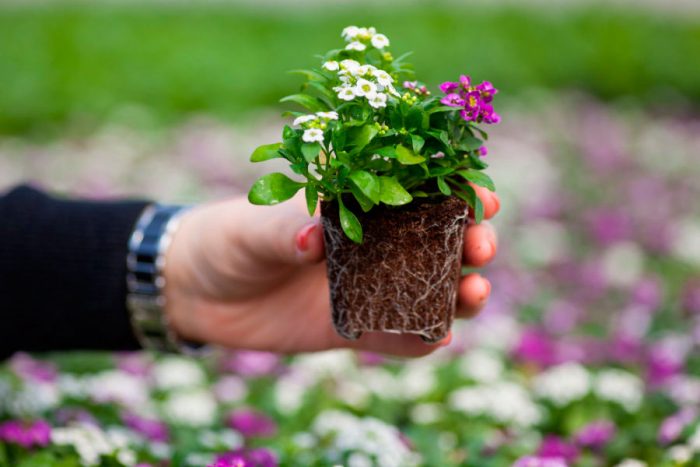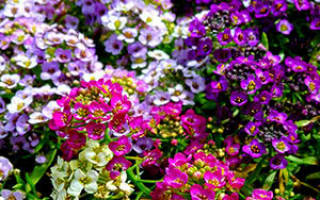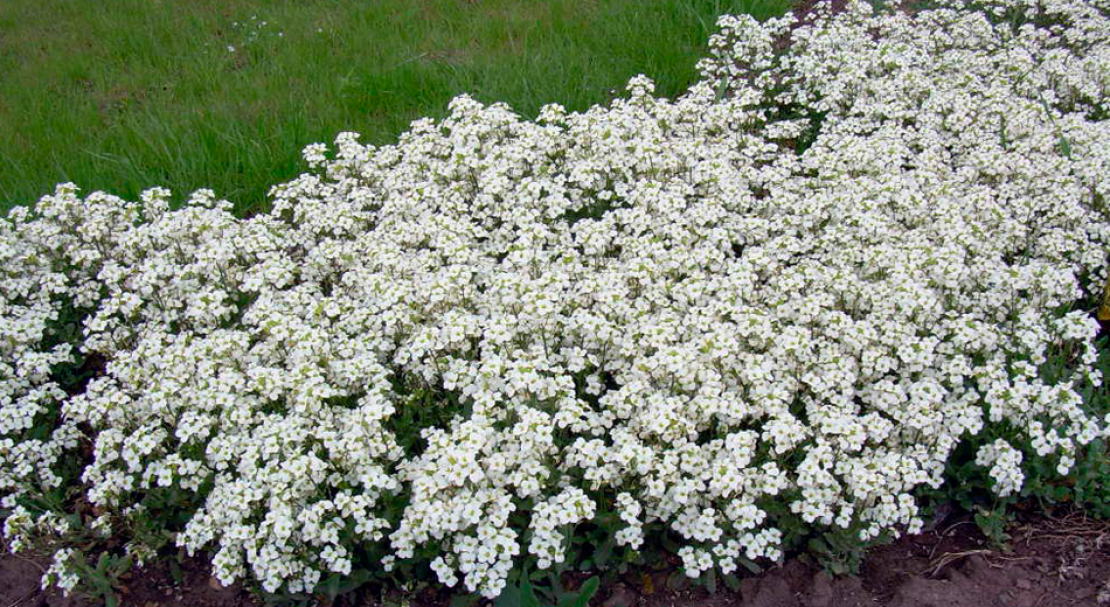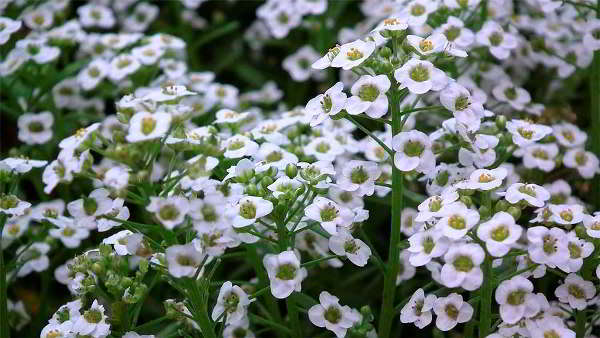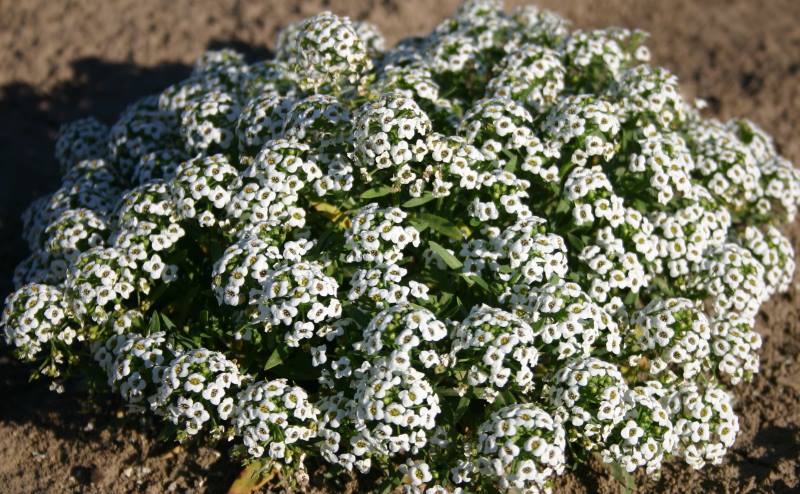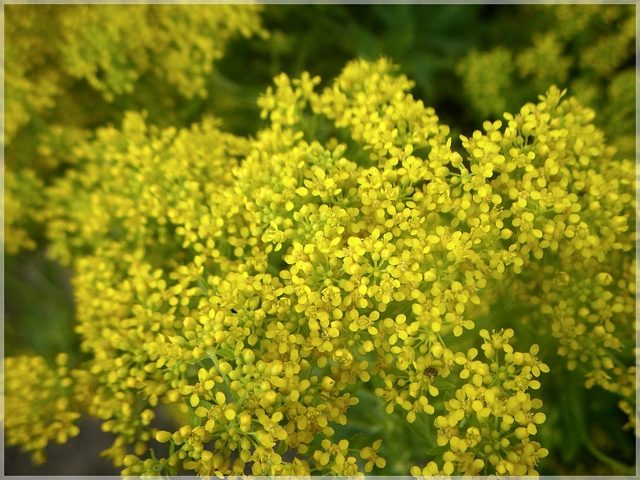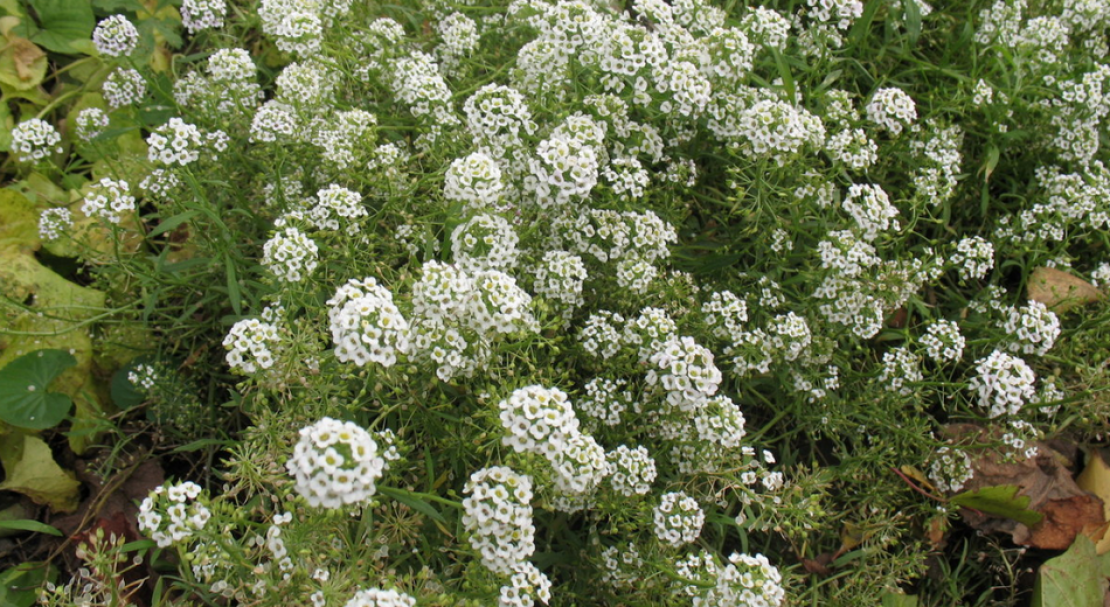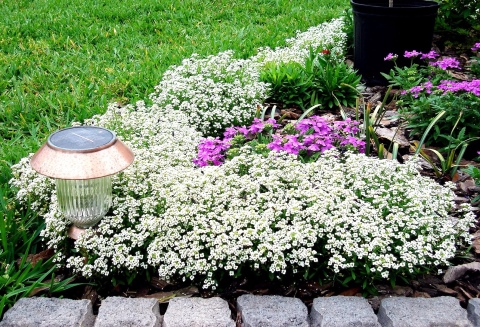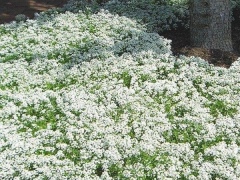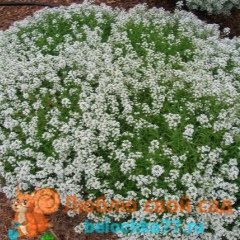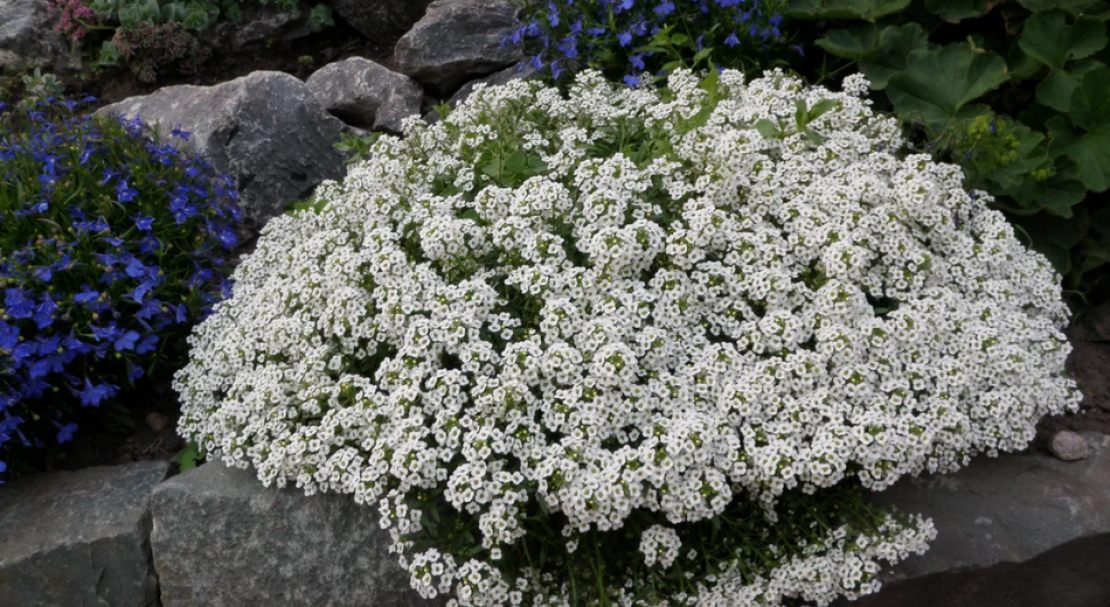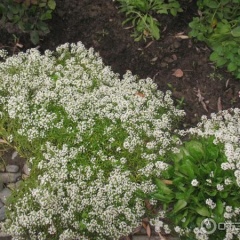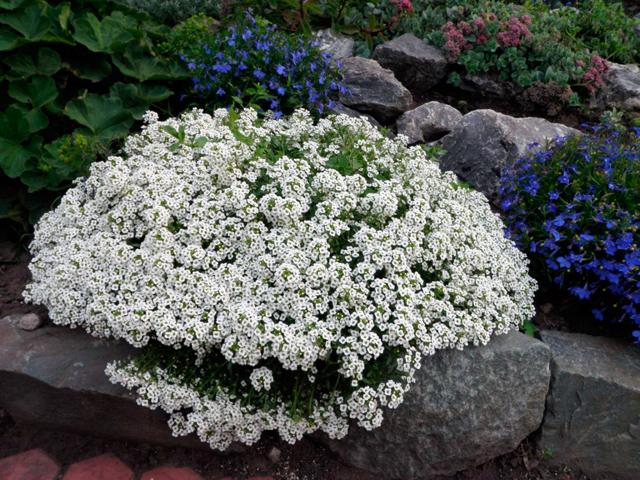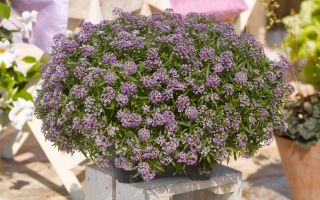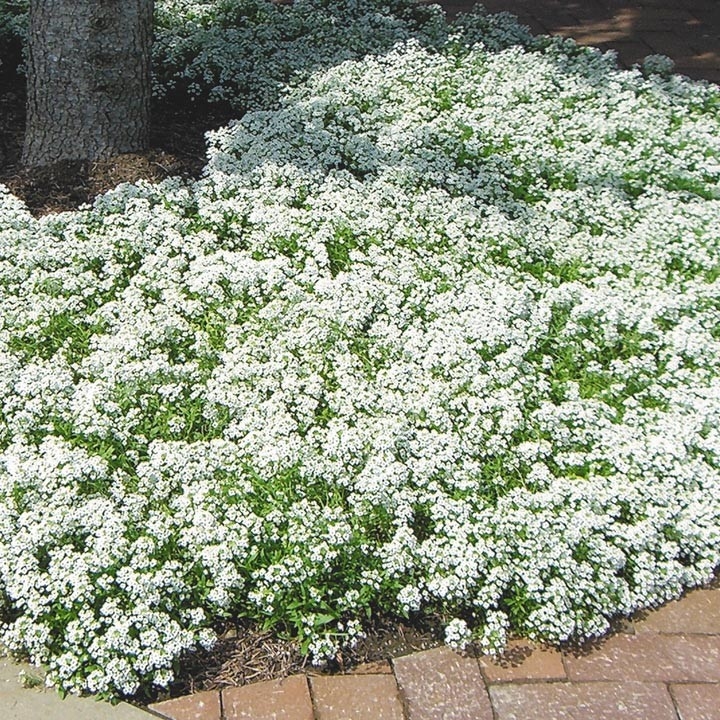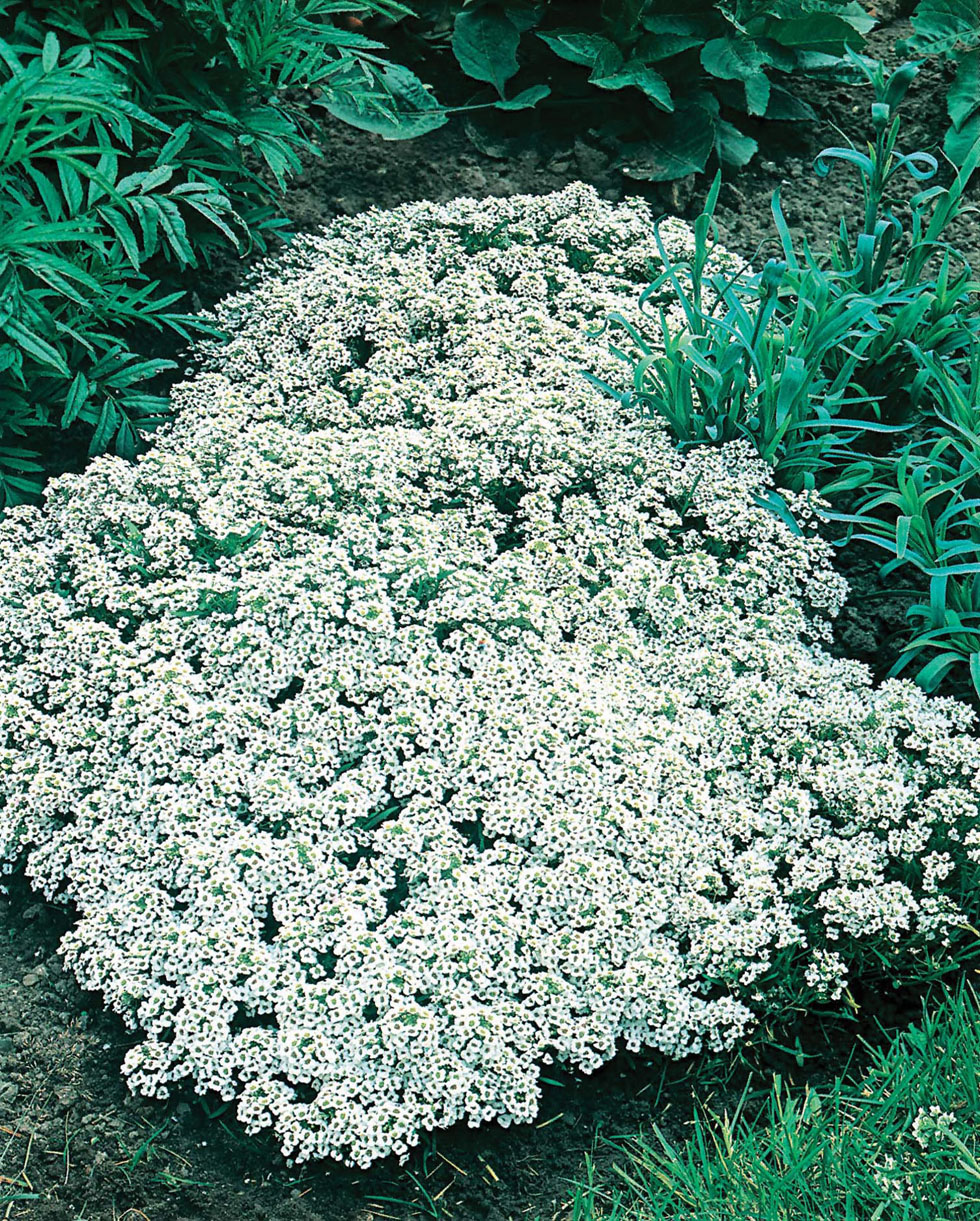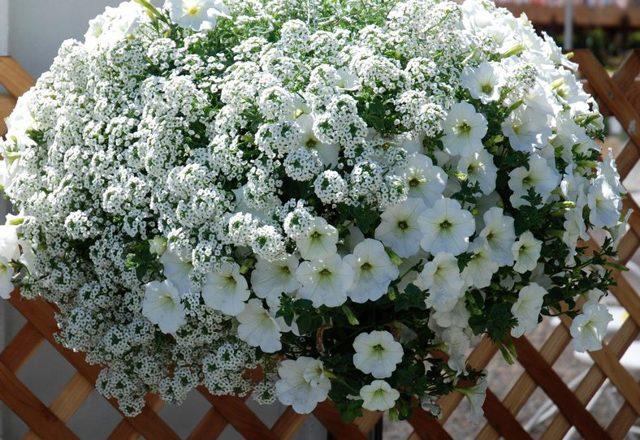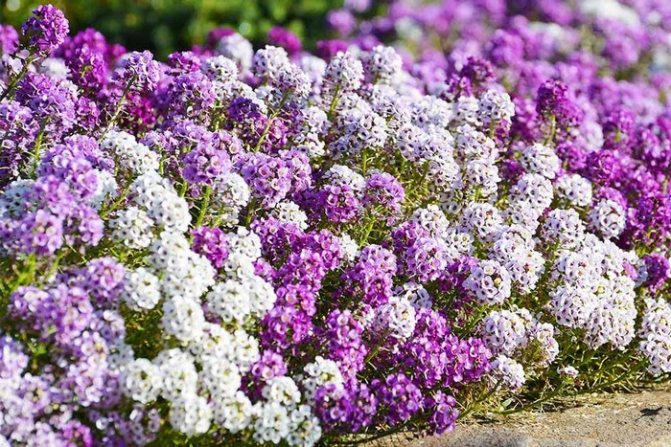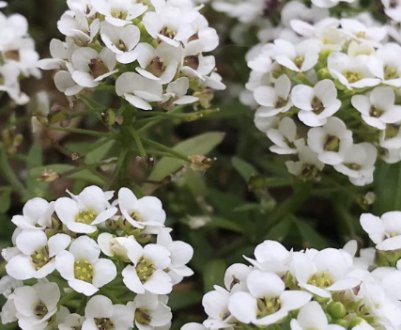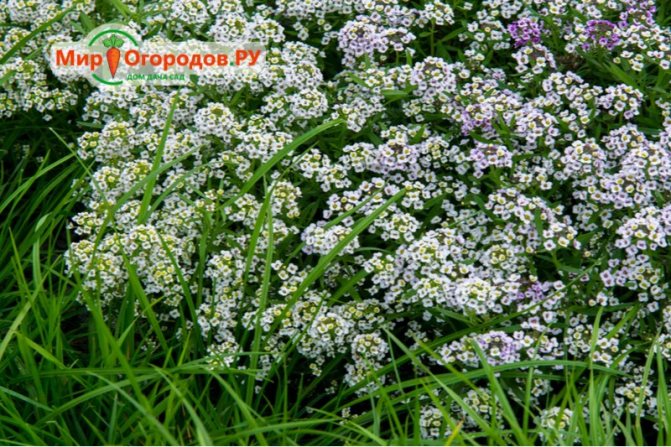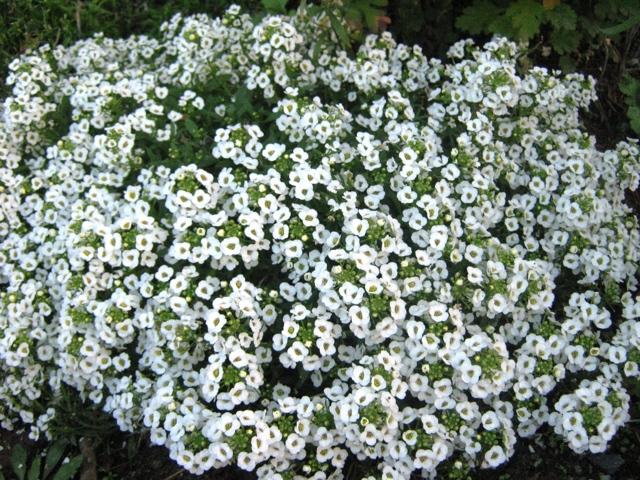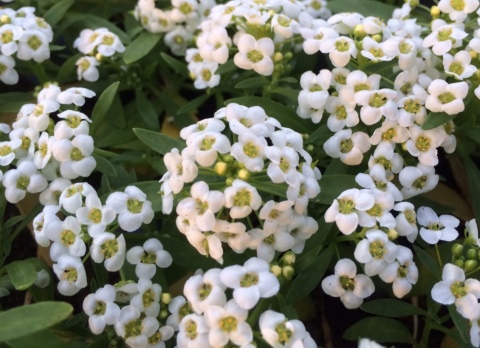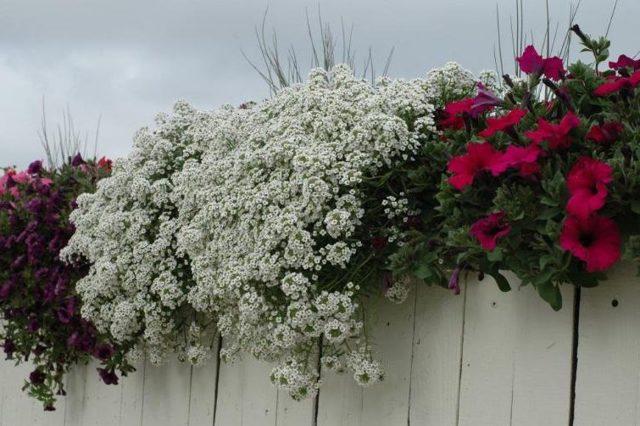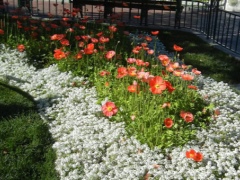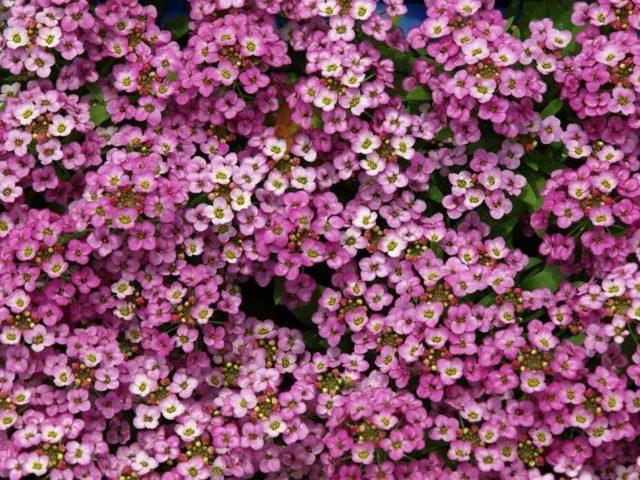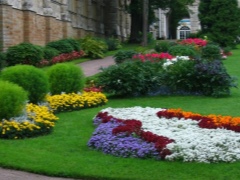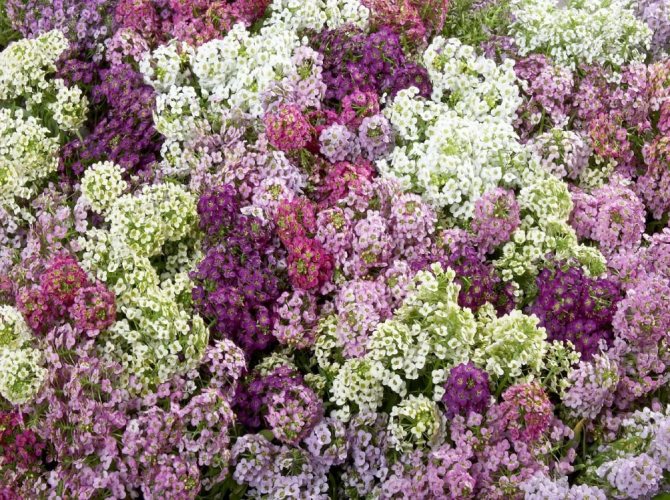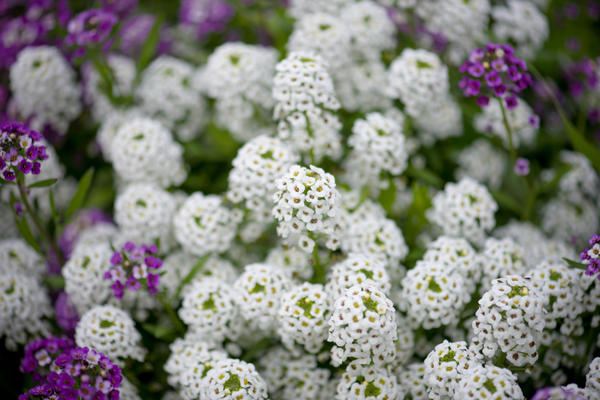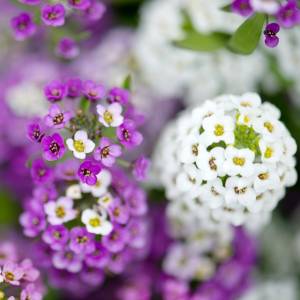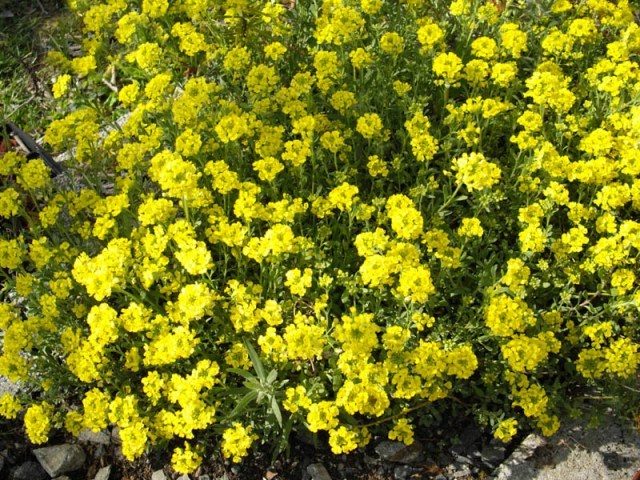Common types for growing in gardens
The genus includes several dozen species of alyssum and more than 200 varieties. In horticulture, only 6 species are grown.
Perennial bushes easily tolerate frost, are recommended for growing in regions with cold climates. Annual plants are more sensitive to the temperature regime, therefore they should be grown in the southern regions, since the seedlings may die with possible return frosts.
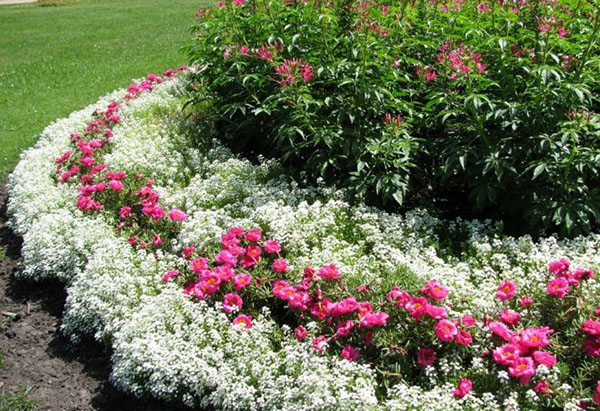
Alyssum is used in the frame of a round flower bed
The difference between perennial and annual alissum lies in the duration of flowering, if the first pleases with flowers only for a month, then the second can smell and thin out a pleasant aroma from mid-summer to mid-autumn.
Rocky
The most common type. With its help, landscape designers create unique compositions in landscaping a personal plot: they decorate borders along paths, paths, lawns. A perennial low plant, the height of the stems does not exceed 20 cm.
Alyssum rocky - a native of the Mediterranean. It was there that it was first used for landscaping.
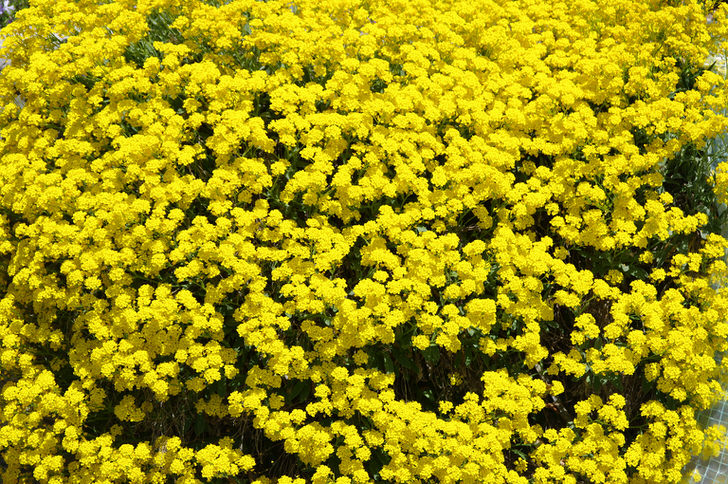
A lemon-yellow scattering of rock alyssum is visible from afar. Flowering is short, only a month
Grows well in moderately moist soils, in open sunny areas. If you choose the right place, the plant will delight the eye with its flowering for a long time. Rock alyssum is suitable for growing in order to hide defects in the area: flowers mask cracks, unsightly stumps, pits.
Mountain
A perennial plant up to 10 cm high. Numerous rosettes with gray leaves create the impression of a dense carpet creeping along the ground. Small yellow flowers, collected in inflorescences, rise above the foliage.
Blooms very early, in April, flowering lasts no more than a month. A luxurious hat of yellow flowers, behind which no foliage is visible, looks friendly on the ground, still bare after winter.
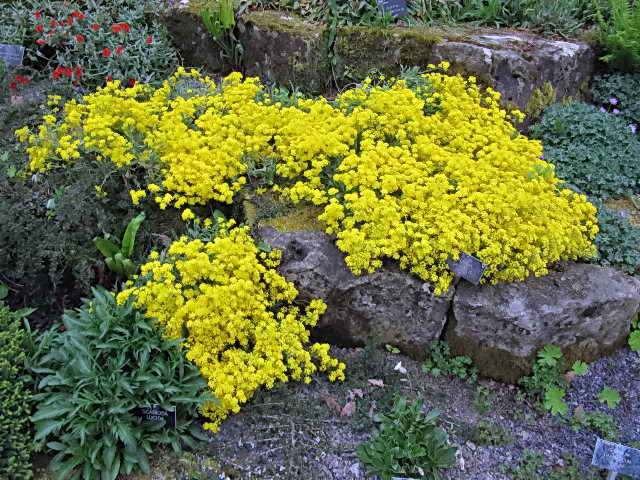
Creating compositions using mountain alissum
Then, in place of the flowers, the capsules ripen. If you do not want to collect the seeds, you should remove all the boxes, as they spoil the whole picture and look unattractive. The plant needs to be pruned.
Marine (lobularia)
A short annual with small, grayish-green, lanceolate leaves, with barely noticeable pubescence. During flowering, the shrub does not exceed 20 cm in height. Inflorescences-clusters with purple, lilac or white, rather small flowers rise above the gray head of pubescent foliage.
Abundant flowering occurs in July and lasts until mid-autumn. So that the wave of flowers does not subside, it is required to cut off the faded flowers in time.
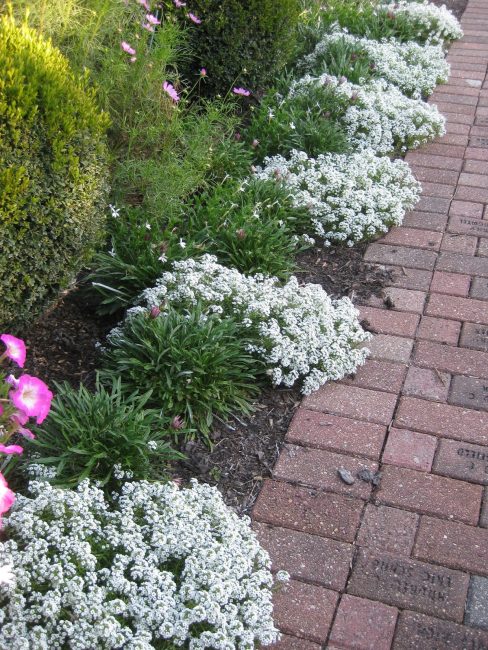
Using a lobularia to fill in the space near a tile on a walkway
What is the beauty of pubescent foliage? The fact is that it is she who helps the plant to endure a short-term drop in temperature. This species grows and develops better on nutrient soils with a neutral reaction.
To ensure lightness to the soil, crushed stone, river sand should be added before planting.
Silver
Vegetative dense rosettes of silvery alissum form a dense carpet. A perennial plant forms wide bushes, similar to an oval, up to 40 cm high. This is the most gigantic specimen of the species diversity.
Foliage develops only in the lower part of erect, numerous stems. The leaves are oblong, decorated with barely noticeable hairs on top, pubescent below, silvery-gray.

The scutellum racemes are composed of numerous lemon-yellow flowers.
Lemon yellow flowers form in corymbose, flat and loose racemes.The plant is frost-resistant, tolerates severe winters with temperatures below -23 ° C degrees.

Potatoes: description of 73 best varieties (Photo & Video) + Reviews of gardeners
Watering
Alyssum is extremely drought tolerant. During the heat, the lack of water often leads to the rejection of both flowering flowers and buds. But over-irrigation is also not recommended, as stagnant water is very harmful. Abundant watering is carried out only when you are sure of the high permeability of the soil. The frequency of watering is selected taking into account the condition of the land.
The Snow Carpet needs water when the soil is 0.03-0.05 m deep. Usually this situation occurs every 4 or 5 days. You can water the plant only with warm, settled water. If there is no urgent need, water the alissum in the evening. Each time thereafter, loosen the soil 0.05 m and mulch it.
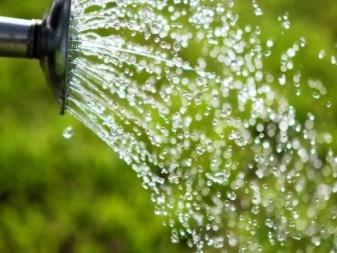

How to properly care for alyssum in the summer
To preserve the beauty of the flower, flower growers regularly water and feed it.
Top dressing
5 weeks after transplanting the crop, it must be fed with nitrogenous and potassium fertilizers. By the time the buds open, you should take care of the nutritional value of the soil. It is saturated with a solution of Agricola-7 mixed with urea.
Annuals are fed 4 times per season, and the first 2 are fed before flowering. Fertilize flowers with complex additives.
Watering
Watering Alyssum is completely excluded if the following conditions are met:
- Precipitation is above average;
- Adequate food;
- Fertile soil.
Watering of Alyssum should be abundant and frequent with permeable light soil. You can determine the degree of moisture empirically: if the ground is dry at a depth of 4 cm, then watering is required.
Florists often mulch immediately after transplanting to reduce watering. This activity does not negate regular loosening.
How to prolong flowering
 It is very pleasant to enjoy the beauty of Alyssum all summer long and inhale its heady aroma. And it’s a pity that the flowering stops soon. It can be extended by watering.
It is very pleasant to enjoy the beauty of Alyssum all summer long and inhale its heady aroma. And it’s a pity that the flowering stops soon. It can be extended by watering.
You should also take into account the tastes of the flower, and plant it in loose soils of moderate moisture. Moreover, the places should be warm, open, well lit. It should contain few nutrients.
With a lack of light, the flowering pillow will become less dense. When satiated with fertilizers, the flower begins to build up a green mass, sometimes ignoring the flowering completely.
The culture requires high-quality loosening and weeding. After the first wave of flowering, the plant should be trimmed a few centimeters to encourage the growth of new flowering shoots.
How to care for alissum - feeding and pruning
Soil care. Growing alissum in the open field includes a set of measures: after watering, it is necessary to loosen the soil around the flower and mulch to rid the plant of weeds and make the soil breathable and permeable.
Top dressing. Top dressing has a positive effect on the health and appearance of the flower crop. Alissum is fed 1 - 2 times over the summer with solutions of fertilizers Agricola-7 and Rainbow (1 tablespoon per 10 liters of water) or organic fertilizer "Flower" (2 tablespoons per 10 liters of water). After top dressing, pour water from a watering can on top to wash off fertilizers from the plants (top dressing with watering is carried out in the morning).
It should be well watered and cut (leave 5 - 6 cm of the stem), abundantly fed with nitrogen fertilizers (dilute 1 tablespoon of urea and Agricola-7 per 10 liters of water), flowering resumes and lasts until deep frost.
Pruning. In July, after the flowering of alyssum begins to decline, pruning is performed - the bush is cut off by half or a third of the length. This work is carried out when the fruits begin to form, but if the grower needs to collect seeds, pruning is postponed until the fruit appears. After pruning, alyssum quickly recovers, overgrows with new shoots and blooms again.After a haircut, it is recommended to apply complex fertilizers.
For better flowering, faded shoots are cut off annually in the spring.
Alyssum care
How to grow alissum
As you can see, planting an alyssum is a simple matter and takes five minutes. It is just as simple to care for it, and it consists in watering the plant, loosening the soil, removing weeds from the site, pruning and feeding alissum.
Watering the plant needs regular, and in dry season plentiful, otherwise, from a lack of moisture, it can throw off flowers and buds. But abundant watering is possible only with good water permeability of the soil, otherwise, from stagnation of moisture in the roots, the alissum will get wet and disappear.
How do you know when it's time to water the alissum? Dig the soil 3-4 cm deep with a shovel, and if it is dry, water it boldly.
After watering, you can easily remove the weeds that have appeared and loosen the soil between the alissum bushes, but if in the spring after planting you mulched the area, then you will have to water and weed much less often, however, loosening and in the presence of mulch is an important component of caring for alyssum, since it provides water - and the air permeability of the soil.
Growing godetia from seeds - everything you need to know
As for fertilizers, during the period of green mass growth, perennial alissum is fed with nitrogen fertilizer at the rate of one tablespoon of Agricola-7 and urea per 10 liters of water, and before flowering, add complex fertilizer to the soil. Annual species need more frequent feeding - about four times per season, provided that the first time fertilization is applied before flowering. Top dressing with the required frequency and in sufficient volume is a guarantee of flowering of annual alissums "for an encore".
In the photo: Purple Alyssum
Pruning alyssum
Timely and correct pruning is very important for full-fledged growth and abundant flowering of alyssum. In the spring, remove last year's flower stalks, dried leaves and weak, diseased shoots from perennial alissums. After summer flowering, repeat the same pruning and shorten all the shoots. plants 5-8 cm, and this will serve as an incentive for the re-flowering of alyssum. In addition, the bushes that have grown over the summer look somewhat sloppy, and pruning will give them a compact and well-groomed appearance.
Alyssum pests and diseases
The most dangerous pest for alyssum is the cruciferous flea, which is difficult to lime unless you resort to treating the plant with a solution of one tablespoon of vinegar essence in 10 liters of water, but only adult, strong plants can be treated.
Caterpillars are also dangerous for alyssum, but treating the bushes with an infusion of chamomile or tobacco with soap will help to remove them.
The boletus is harmed by cabbage moths and white beetles, which are destroyed with Entobacterin or Lepidocide.
In the photo: Blooming yellow alyssum
With chronic waterlogging or insufficient water permeability of the soil, Alyssum may develop brown rot - late blight, affecting the underground part and the root collar of the plant. In this case, try to carry out the treatment with copper oxychloride or fungicides - Ordan, Thanos or Cuproxat.
Alyssum infection with viral mosaic or powdery mildew (real or false) can occur. Powdery mildew is destroyed by treatment with Bordeaux liquid or Topaz. And downy mildew - oxychom, ordan and Bordeaux mixture. The viral mosaic is not cured.
Lobularia care in the garden
How to care for Lobularia
Planting lobularia and caring for this ornamental plant in the open field will not seem tiresome to you. You will need to water the flower garden from time to time, loosen the soil, remove weeds, and mow the lawn.
Prune the plant when the first stage of flowering is completed, and the stems are cut as low as possible. After pruning, the lobularia will begin to grow, quickly recover and bloom again on the eve of autumn, and even more magnificently than the first time.
Many new, recently developed varieties do not need pruning and resume flowering themselves as soon as the heat subsides.
Watering and feeding lobularia
It is not necessary to water the lobularia, well, except that an abnormally hot and dry summer will come. However, even with systematic watering and the most careful care, you will not make this plant bloom in extreme heat. There is also no need to feed the lawn.
In the photo: Growing lobularia from seeds
Lobularia pests and diseases
Lobularia is one of the most resistant to plant diseases and pests. She risks getting sick only as a result of improper planting: Lobularia growing too densely is sometimes affected by powdery mildew and other fungal diseases. Remove the affected specimens, and treat the rest of the plants with a fungicide solution.
Of the pests, slugs and a cruciferous flea, a malicious pest of cabbage crops, are dangerous for the lawn.
Flea beetles are destroyed by treating the flower garden with the drugs Decis, Aktellik, Karate, Bankol or Aktara.
And it is better to collect slugs by hand or lure them into a trap - a glass jar dug up to the throat into the ground, a third filled with beer or fermented compote.
Growing from seeds
Alyssum is grown through seedlings or by sowing seeds in open ground.
For growing seedlings in the spring, prepare boxes or pots and a loose soil mixture. The soil is used in the store or added to a mixture of peat, garden soil, humus and sand prepared on its own. All components are taken in equal parts.
Before sowing, the seeds are soaked for 5–6 hours in a solution of growth stimulants. Then they are slightly dried and sowed. The ground in the box is leveled and grooves are marked. Alyssum's seeds are small, they are placed in rows to a depth of no more than 2-3 mm. The distance between the seeds is 1-1.5 cm. The grooves are sprinkled with sand and sprayed with water from a spray bottle.
The boxes are covered with foil or glass and placed in a warm place with an air temperature of 23-25 ° C. Seedlings appear quickly, after 4-7 days the first shoots are visible. The shelter is removed from the containers. If the sowing was carried out early - in early March, then the seedlings are illuminated. If sown in late March - early April, then additional lighting is not required during this period. After emergence, the temperature is lowered to 18–20 ° C. It is best to transfer young plants to a glazed balcony. In a warm room, the seedlings will quickly begin to stretch. Seedlings are watered moderately, avoiding waterlogging.
When the grown seedlings have 2-3 true leaves, a pick is carried out
The delicate plants are carefully removed from the soil and transplanted one at a time into a larger box. Instead of boxes, you can dive alissum into separate pots or seedling cassettes with a diameter of 6-8 cm, 2 pcs in each cell
A row is marked out in a common container and seedlings are laid out in it at a distance of 3–3.5 cm from each other. They move the earth with a wooden ruler, filling the row. The soil around the seedlings is compacted. After 4–5 cm, new rows are marked and the rest of the plants are replanted.
Alyssum is sown in open ground when the ground warms up - in late April - early May. Seeds are spread sparsely into grooves to a depth of no more than 3 mm. They are sprinkled on top with earth or compost and watered. If the weather is dry, the crops are covered with lutrasil. The shelter is removed after the emergence of seedlings, and after 2 weeks the seedlings are thinned out. A distance of 15–20 cm is left between them. Excess plants can be transplanted to another place.
To get constantly blooming alissum of different shades, crops are sown several times at intervals of 2 weeks.
To get early shoots in spring, seeds can be sown in late autumn. Spring seedlings are strong, healthy and grow quickly. The soil for winter crops is prepared in advance before the ground freezes. Grooves are marked on the beds - they should be deeper than during spring planting - 4–5 mm. Seeds are sown when a frozen "crust" forms on the soil. Sprinkle the rows with compost or peat.

